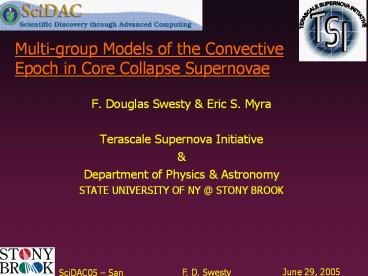F. Douglas Swesty - PowerPoint PPT Presentation
1 / 13
Title:
F. Douglas Swesty
Description:
Multi-group Models of the Convective Epoch in Core Collapse Supernovae ... Francesca Verdier, Wes Bethel, Richard Gerber, David Skinner, John Shalf, Eli ... – PowerPoint PPT presentation
Number of Views:13
Avg rating:3.0/5.0
Title: F. Douglas Swesty
1
TERASCALE SUPERNOVA INITIATIVE
Multi-group Models of the Convective Epoch in
Core Collapse Supernovae
- F. Douglas Swesty Eric S. Myra
- Terascale Supernova Initiative
- Department of Physics Astronomy
- STATE UNIVERSITY OF NY _at_ STONY BROOK
2
Stellar Core Collapse -Massive stars evolve by
burning lighter Elements, by thermonuclear
fusion, into heavier elements -High mass stars
will produce elements Up to Silicon Sulfur ,
which then burn into Iron -Star has an
Onionskin-like structure With layers of
successively heavier elements -Each burning
stage progresses More rapidly -When the Iron
core mass becomes about 1.2-1.4 solar masses the
core can no longer sustain itself against the
pull of gravity it collapses
3
- Core Collapse Bounce
- -Iron core collapses in 1/100th of a second
- Neutrinos are produced e- p ? n ne
- -Neutrinos escape from the collapsing
- core until the material becomes too
- dense
- -The core collapses until densities
- of about 2.5 x 1014 g/cm3 is reached
- -Nuclear forces cause the collapse
- to halt and the core rebounds outward
- -Outward moving core forms a shock wave
- when it hits the exterior regions where
4
Convection in Core-Collapse SupernovaeHow
convection complicates the picture
ne, nm nt
5
Neutrino Radiation-Hydrodynamic Model
6
Parallel Implementation
Problem split up into one spatial sub-domain per
processor
Global Problem Domain
Adjacent processes in Cartesian topology
must exchange ghost zones when needed by
algorithms
- Code (V2D) written in F95
- Continuous process of Verification Validation
- Componentized architecture
- Message passing done in MPI
- Parallel I/O done with parallel HDF5
- Scalable to at least 1024-2048 processors for
medium sized problems
7
Implicit Neutrino Transport w/ Newton-Krylov
Iteration
N-K solution accomplished via Newton-BiCGSTAB
Currently using sparse parallel approximate
inverse preconditioning (physics based) --
highly parallel MATVECS can be carried
out asynchronously to hide communication
BiCGSTAB can be restructured to reduce global
reductions Typically 10-20 Bicgstab iterations
per Newton iteration 2-3 Newton iterations Impli
cit solvers have to be ultra-fast -- few x
105 timesteps to complete
simulation! Currently Incorporating TOPS
SUNDIALS solvers into V2D for fully implicit
radiation-hydro
8
Data Management Networking Challenges
- Couldnt handle the data with LBONE Depots LORS
Tools! - Scientific Process Automation (SPA) systems is
easing workflow management tremendously!
75 msec
Chicago
NERSC
Stony Brook
32AoA
Sunnyvale
9
- Prior to SciDAC state of the art was
- 2-D models with gray transport approximation
(produced explosions assumed distribution
function approximated rates opacities no
dynamic diffusion in Eulerian models) - Uncoupled radial-ray multi-group models (saw no
explosions lacked full coupling no lateral
movement of neutrinos no dynamic diffusion) - SciDAC has enabled
- Fully coupled 2-D radiation-hydrodynamic MGFLD
models - Fully coupled 2-D Boltzmann transport models
(coming soon!)
Models of the Convective Epoch
- Baseline Model
- -S15S7B progenitor model of
- Woosley Weaver
- -Neutrino Physics at the level
- of Bruenn (1985) w/ NES turned off
- EOS is LS K180 MeV model
- -Collapse run to r1014 g/cm3 w/
- 1-D Lagrangean code
- -Baseline model does not
- explode on timescales of 35 msec
10
- Behavior of Baseline Model
- Shock stagnates on timescales of 30 msec
- Shock is strong flow into it _at_ Mach 4
- Shock initially shows large scale SASI mode
which - dies out shock circularizes
- Could this reinitialize at later times?
- We see convection in both
- The proto-neutron star (in optically thick
regions - below the neutrinosphere)
- Between stalled shock neutrinosphere
- Vigorous Proto-Neutron Star convection is
entropy - driven and is short-lived
11
- PNS convection
- PNS convection gives rise to a
- fast burst of deleptonization
- PNS instability is initiated and
- driven by an unstable entropy
- gradient around neutrinosphere
- Higher Ye (0.3) material gets
- advected upward allowing it to
- deleptonize around neutrinosphere
- PNS convection enhances
- neutrino luminosity in a burst
- but does not maintain this
- enhancement
- Dynamic diffusion term r(E? v)
12
- We now have a computational laboratory to explore
effects - on nuclear and particle physics in
convective epoch of supernovae - Currently starting to look at effects of nuclear
force parameters such as the nuclear symmetry
energy, nuclear specific heat effective masses - Effects of neutrino electron scattering and other
neutrino physics - NES models are coming very soon!
- Will be looking at neutrino flavor mixing
- Other progenitor models
- Will be extending simulations to later times
- Can the SASI occur in baseline model at later
times? - Fully implicit hydro is in development and
testing - Will allow us to solve technical limitations in
looking at PNS convection - Will enable us to calculate neutrino signal
- Fully implicit radiation-hydro
- Eliminate operator splitting and allow
higher-order time integration - 3-D Models with AMR
- Accurately characterize convection
- Will be able to deal with rotation
The Future
13
The Stony Brook TSI web sitehttp//nuclear.astro
.sunysb.edu
- TSI Team members
- Ed Bachta, Polly Baker (Indiana Univ. _at_
Indianapolis) - Dennis Smolarski (Santa Clara Univ.)
- Jim Lattimer (Stony Brook)
- TOPS ISIC Team members
- Dan Reynolds, Carol Woodward (LLNL)
- SDM ISIC Team members
- Terrence Critchlow, Xiaowen Xin (LLNL)
- LBONE/LORS SAPP Team members
- Micah Beck, Scott Atchley, Hunter Hagwood (Univ.
of Tenn.) - CCA ISIC Team Members
- Rob Armstrong (SNL), Gary Kumfert (LLNL), David
Bernholdt (ORNL) - APDEC ISIC Team Members
- Donna Calhoun (Univ. of Washington)
- NERSC Staff
- Francesca Verdier, Wes Bethel, Richard Gerber,
David Skinner, John Shalf, Eli Dart, Brent Draney
Thanks to those who have contributed!































